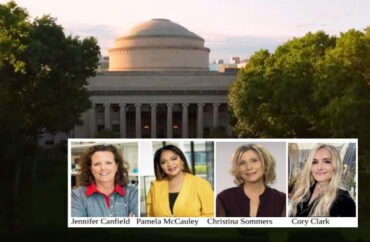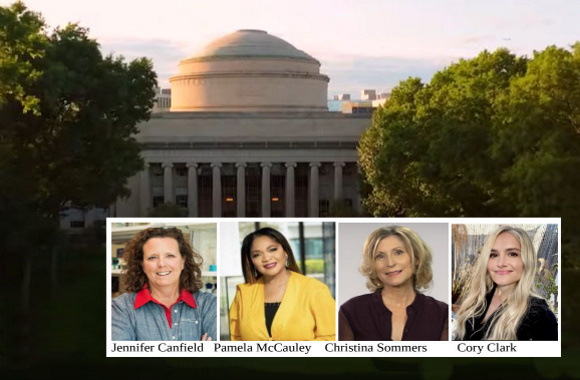
A panel of prominent female scholars took to the stage recently at one of the nation’s most prestigious STEM universities to debate the fiercely contested topic of sexism in science.
“It’s 2025, not 1970,” said Christina Hoff Sommers, author and senior fellow at the American Enterprise Institute, who argued against the need to close an alleged gender gap in STEM.
“Look around,” Sommers said at the April 30 event. “The educational landscape has changed. Women have not merely closed gaps in key areas of STEM, they’re doing better than men.”
The debate, hosted by the MIT Free Speech Alliance and MIT Open Discourse Society, had the scholars debate the resolution: “We must close the gender gap in STEM.”
Systemic barriers prevent greater female involvement in STEM and must be torn down for women to enjoy financial independence and for America to maintain supremacy in an increasingly technological world, argued Pamela McCauley, dean of the School of Engineering at Widener University, and Jennifer Roecklein-Canfield, chair of the Department Chemistry and Physics at Simmons University, who took the affirmative position.
“As we enter into this new era of global competitiveness and artificial intelligence, quantum computing, biotechnology, clean energy, and many other areas, every brain will count,” McCauley said.
“Closing this gender gap in STEM is a strategic necessity for the United States,” she added. “It will unlock hundreds of billions of dollars in economic growth, supercharge innovation and business success, and strengthen our national security. It will also secure America’s leadership in the global race for innovation and progress.”
Sommers, along with Cory Clark, a behavioral scientist at the University of Pennsylvania and the executive director for the Adversarial Collaboration Project, argued the alleged systemic barriers decried by McCauley and Roecklein-Canfield were abolished decades ago.
What differences remain in STEM fields result from differences in the aptitudes and interests of males and females, they said.
“One of the most robust and broadly true findings in psychology is that girls and women are relatively more interested in people and boys and men are relatively more interested in things,” Clark said.
“Women tend to be attracted to organic fields of study such as social sciences, humanities, biology, and medicine,” she said, “and men are relatively attracted to inorganic fields of study such as engineering and the physical sciences.”
“When educational and career opportunities opened to women decades ago, they made rapid progress and have surpassed men in the disciplines that interested them and [in] most disciplines, in fact,” Clark added.
Sommers cited how women currently make up the majority of college graduates, graduate degree recipients, biology and chemistry degree recipients, and medical students, while also completely dominating the social sciences.
The affirmative team did not attempt to refute these claims, but instead highlighted that men still make up the majority of students in mathematics, physics, engineering and computer science.
Clark acknowledged these disparities, but held that they were likely accounted for by men and women having different interests and making different choices regarding their academic and professional careers.
The reason women have not reached parity with men in physics and engineering, Clark said, is “not because sex barriers were held up in only these disciplines while they crumbled in all other disciplines, but because women on average have less interest in these disciplines.”
“Even among men and women in the top 1 percent of mathematical ability, where they all have the competence to pursue any discipline in STEM they want…women are still more interested in disciplines involving people,” she said.
Moreover, Clark said, “mathematically gifted women are also more likely than mathematically gifted men to also be verbally gifted – they’re more balanced, which is a typical female advantage.”
“These women,” Clark said, “are more likely to change their major – leaky pipeline – out of math and science into other disciplines.”
These choices, she said, should not be viewed as a deficiency in women nor as a societal tragedy that needs to be corrected.
Sommers at one point joked that this might “solve the mystery” of why her “mathematically precocious granddaughter” chose to study film.
Moving beyond the formal proposition of the debate, corollary topics were also discussed, such as why males are showing deficits in literacy, school attendance, college graduation, and workplace participation, as well as why certain segments of society do not seem to care.
“The gender equity movement deploys an unusual logic,” Sommers said. “Gaps favoring men, those are evidence of invidious discrimination. They demand massive attention, including national legislation. Gaps favoring women, no matter how large, no matter how momentous … those go unmentioned.”
Additionally, on multiple occasions, the negative side questioned whether the larger debate was about ensuring women have a fair opportunity to pursue careers in STEM or about achieving statistical parity in every STEM discipline, which Clark argued could only be achieved through “top-down social engineering that is a mix of soft coercion against women and illegal sex discrimination against men.”
The entire debate can be viewed on the MIT Free Speech Alliance YouTube page.
MORE: Professor defends call to institute grading curve to shrink gender gap in STEM
IMAGE CREDIT AND CAPTION: A photo of MIT from above with headshots of the debate panelists / YouTube screenshot and courtesy photos
Read More
Like The College Fix on Facebook / Follow us on Twitter


